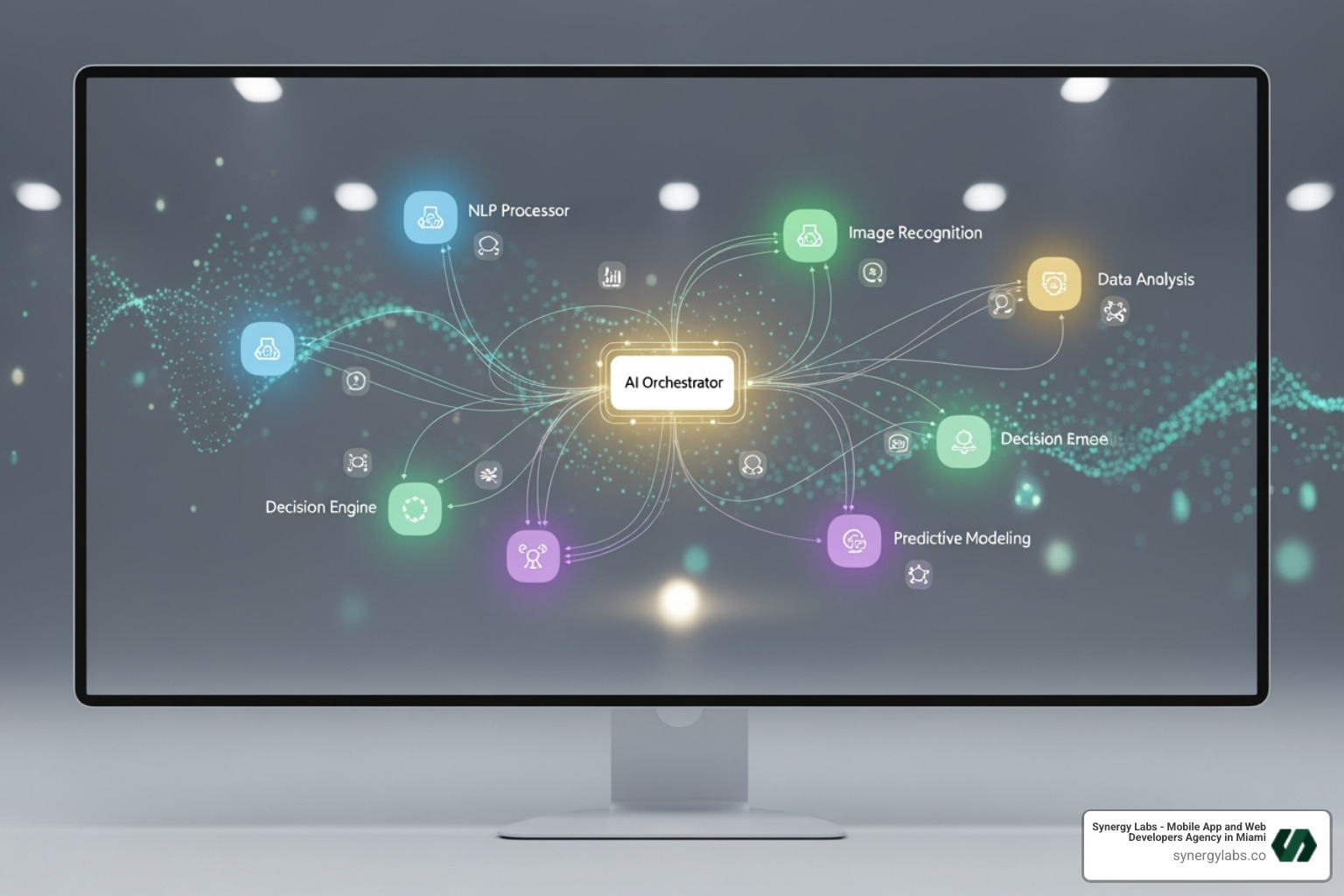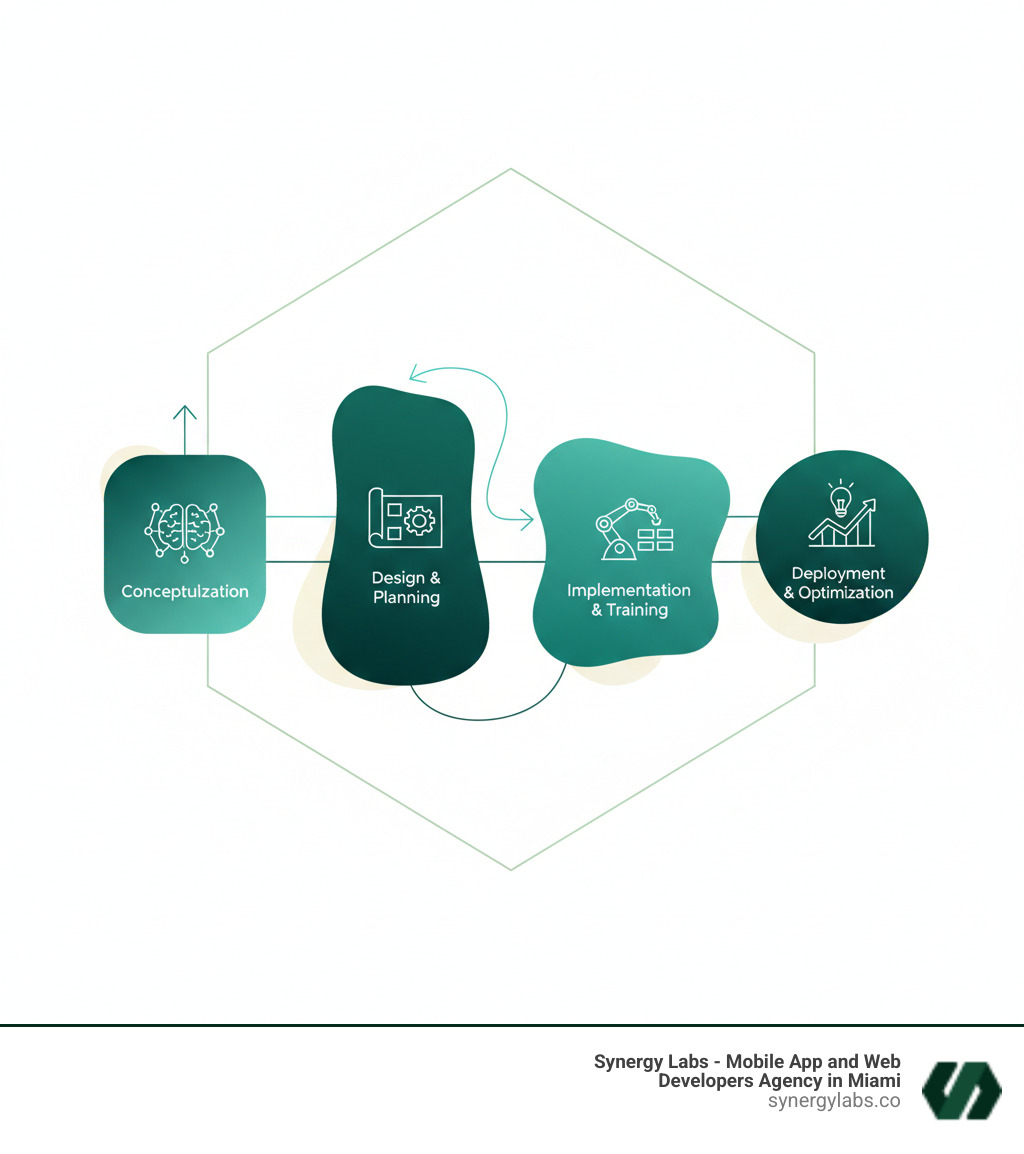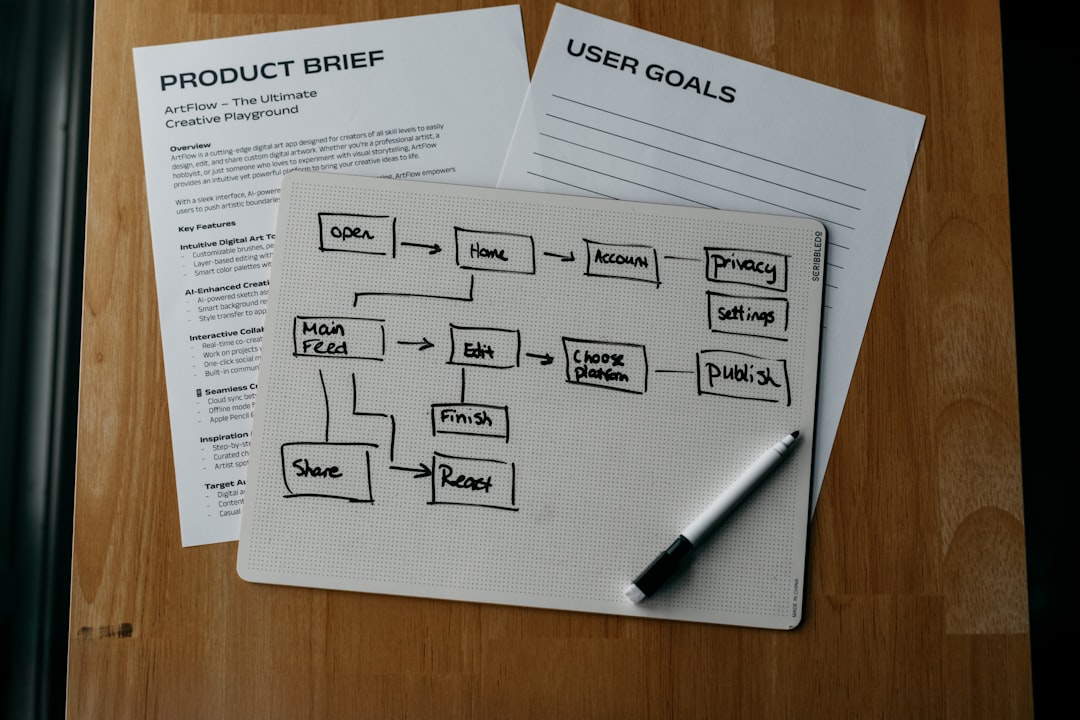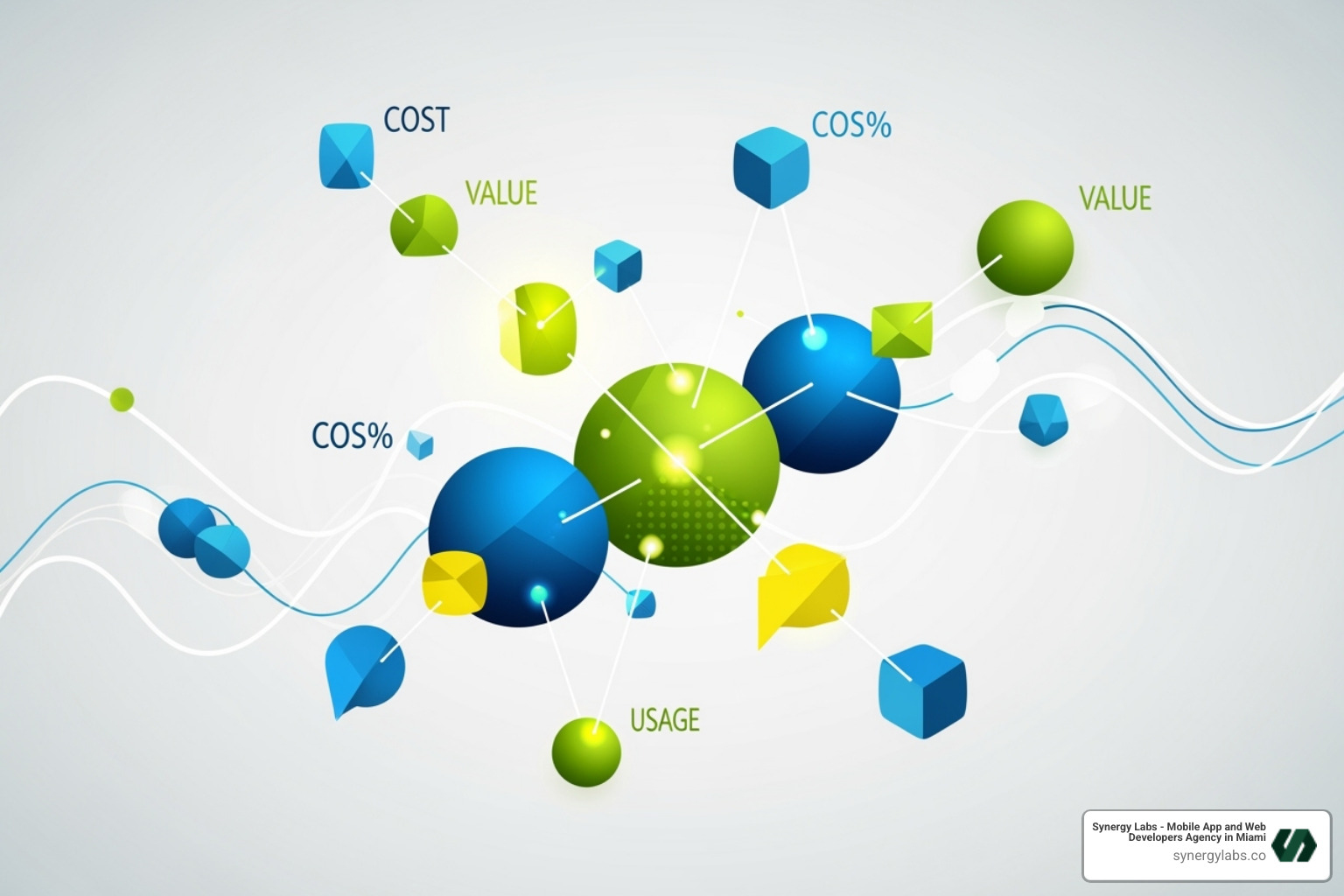الشراكة مع وكالة من أفضل الوكالات
حدد موعدًاللاجتماع عبر النموذج هنا و
سنقوم بتوصيلك مباشرةً بمدير المنتجات لدينا - دون مشاركة مندوبي المبيعات.
هل تفضل التحدث الآن؟
اتصل بنا على + 1 (645) 444 - 1069
"A comprehensive framework designed to simplify building, testing, and deploying intelligent AI agents."

Deep Dive: AgentKit — OpenAI's New Toolkit for Smart AI Agents is a comprehensive framework designed to simplify building, testing, and deploying intelligent AI agents. As AI agents become central to development in 2025, this toolkit provides a clear starting point.
Quick Overview:
Traditionally, building an AI agent required juggling multiple models, APIs, and workflows, resulting in weeks or months of development before an idea could even be tested. AgentKit changes this by providing an integrated ecosystem that handles the heavy lifting, much like using an assembly line instead of building a car from individual parts.
At Synergy Labs, our teams help clients rapidly prototype and deploy AI-powered applications by turning complex technical concepts into actionable, value-driven solutions. This guide breaks down how AgentKit works, its strengths, and its limitations to help you determine if it's the right approach for your project.

Easy Deep Dive: AgentKit — OpenAI’s New Toolkit for Smart AI Agents glossary:
Deep Dive: AgentKit — OpenAI's New Toolkit for Smart AI Agents is not a single product but a suite of tools from OpenAI designed to streamline the creation, testing, and launch of AI agents. Its primary goal is to reduce the friction of moving from prototype to a reliable, production-ready system. Previously, building agents involved juggling separate tools for models, workflows, UI, and safety. AgentKit unifies these fragmented pieces into a cohesive stack.
Under the hood, AgentKit builds on OpenAI's existing foundations, leveraging the Responses API for unified chat completions with tool use, and the Agents SDK (Python) for code-level control over agents, tools, and guardrails. AgentKit wraps these elements in a higher-level infrastructure with visual tools and deployment controls. You can learn more from the official announcement at Introducing AgentKit.

AgentKit comprises four core components that handle specific parts of the development process.
Agent Builder is a visual canvas for designing multi-agent workflows. Using drag-and-drop actions, you can map out an agent's logic, connect tools, define branching, and set up safety guardrails without extensive coding.
ChatKit provides production-ready, embeddable chat interfaces for your website or app. This eliminates the need for custom frontend development while allowing customization to match your brand.
Evals is the quality control framework. It ensures agents perform correctly and reliably in real-world scenarios, moving beyond impressive demos to dependable applications.
Finally, the Connector Registry offers centralized data and tool management for enterprises. It allows administrators to control how data and tools connect across OpenAI products in a secure, audited location.
Traditional AI agent development is complex and time-consuming, involving separate integrations for models, APIs, workflows, and UIs. This fragmented approach often takes months.
AgentKit streamlines this with an integrated ecosystem that features a visual-first design approach and pre-built components, drastically reducing boilerplate code. This enables faster iteration cycles, allowing developers to focus on creating innovative solutions. Teams have reported building functional agents in hours, a task that previously took months. This streamlined process means developers spend less time on infrastructure and more time refining agent behavior. As OpenAI notes, AgentKit is a suite of tools that OpenAI released to make the journey from prototype to production as smooth as possible.
Understanding what AgentKit is, let's explore how it works in practice. This section provides practical insights into how its components create useful, intelligent agents.

The Agent Builder provides a visual canvas where you can map an agent's decision-making process. By dragging and dropping nodes representing workflow steps, tools, or logic branches, you can build a functional agent workflow without writing orchestration code. This visual approach improves transparency, allowing both technical and non-technical team members to understand the agent's logic.
Built-in version control allows for safe experimentation, and a live preview feature lets you test the agent in real-time to catch issues early. Integrated guardrails help ensure reliable execution and prevent unsafe behavior. To get started, navigate to Agent Builder on the OpenAI platform.
ChatKit solves the tedious problem of building a polished chat interface from scratch. It offers production-ready, embeddable UIs that can be dropped into any website or application. ChatKit includes 21 interactive widgets, such as cards, buttons, forms, and date pickers, to create dynamic and intuitive conversations.
Extensive customization options allow you to match the interface to your brand's look and feel. By handling frontend complexity, ChatKit lets developers focus on agent functionality rather than UI development, a significant time-saver for teams at Synergy Labs working on rapid prototyping sprints.
AI agents can be unpredictable, which is why the Evals framework is crucial for quality assurance. It provides systematic testing to build confidence in your agent's performance before deployment.
The framework allows you to create datasets of inputs and expected outputs to test your agent against real-world scenarios. Trace grading offers a detailed look into the agent's execution path—its decisions, tool calls, and reasoning—making debugging much easier. The framework can even suggest automated prompt optimizations based on performance data, creating a cycle of continuous improvement. For setup details, see the Evals guide in OpenAI's documentation. This process separates impressive demos from reliable, production-ready systems.
With AgentKit, OpenAI is presenting a new paradigm for building and interacting with AI. This Deep Dive: AgentKit — OpenAI's New Toolkit for Smart AI Agents reveals both exciting possibilities and important considerations for developers and business leaders.

The strategic implications of AgentKit are vast, turning the abstract idea of "AI agents" into deployable systems. At Synergy Labs, we've seen this technology reshape workflows.
Beyond this, agentic commerce emerges as a possibility, with agents potentially transacting on behalf of users. The platform could also create new SaaS distribution channels, allowing "agent-first" companies to leverage ChatGPT's massive user base. AgentKit lowers the technical barrier for deploying intelligent automation across nearly any industry.
AgentKit's Agent Builder offers a visual, intuitive way to integrate AI into processes. This AI-first design shines for rapid prototyping and ensuring transparency. However, there are flexibility trade-offs.
Some developers find the visual workflow can enforce a rigid, sequential approach. Instead of an agent intelligently picking the right tool, developers may need to manually insert 'if/else' nodes for every decision path, which can lead to overly complicated workflow diagrams.
The platform's tight integration with OpenAI is great for getting started quickly but creates a dependency on OpenAI's models and methods. Organizations needing graph-based state control, persistent memory, or extensive open customization may find this limiting. It's a classic trade-off between ease of use and ultimate control.
While groundbreaking, AgentKit has limitations for enterprise-grade deployments.
The rigid sequential logic becomes problematic as complexity increases, making sophisticated, non-linear reasoning difficult to map without creating tangled workflows.
Manual knowledge updates are another challenge. The "File Search" tool requires manual document uploads, which is an operational headache in dynamic environments where information changes constantly. This can make it difficult to justify for production use in certain business cases.
Vendor lock-in is a key strategic consideration. AgentKit works exclusively with OpenAI's models, tying your operation to a single company's pricing and roadmap.
An enterprise readiness gap exists. While offering controls like SSO and RBAC, the platform currently lacks key certifications like SOC 2 or HIPAA, a roadblock for regulated industries like healthcare and finance.
Finally, security and governance require careful implementation. While native guardrails exist, ensuring comprehensive security for sensitive data often requires human-in-the-loop mechanisms for reviewing and approving critical decisions. These factors mean that while AgentKit is a powerful starting point, significant work may be needed to adapt it for robust, compliant, and scalable enterprise environments.
Let's cover the practicalities: cost and initial setup. AgentKit is designed for accessibility, but understanding its pricing and first steps is key.

AgentKit does not have a separate subscription fee. Instead, it follows OpenAI's standard usage-based API pricing model, where you pay for what you use.
The primary cost is model token usage. Every time an agent processes information, it consumes tokens from OpenAI's models. ChatKit storage costs are minimal, with 1 GB of free storage per month and subsequent usage billed at $0.10 per GB-day.
Importantly, billing doesn't start until November 1, 2025, providing a grace period for experimentation. Several powerful features are also completely free, including the Agent Builder for workflow design (you only pay for token usage upon execution) and enterprise controls like SSO, RBAC, and audit logs. If you self-host ChatKit, you only pay for the underlying model usage.
For a full breakdown, see the official OpenAI API pricing page. This model incentivizes building efficient agents that minimize token consumption.
Building a working agent with AgentKit can be done remarkably quickly. OpenAI's minimal path emphasizes learning by doing.
OPENAI_API_KEY) for security.For developers who prefer code, the Agents SDK Python quickstart offers a similar path with programmatic control. This step-by-step approach gets you from zero to a functioning prototype in hours, not weeks.
As with any new technology, common questions arise. Here, we address frequent queries about Deep Dive: AgentKit — OpenAI's New Toolkit for Smart AI Agents.
These two components are related but serve different needs. AgentKit is the higher-level, unified framework with a visual-first approach. It bundles tools like Agent Builder, ChatKit, and Evals to reduce boilerplate code and streamline development. It's ideal for rapid prototyping.
The Agents SDK (Python) is the underlying code-first library that AgentKit is built upon. It provides granular, programmatic control over defining agents, tools, and guardrails. In short, AgentKit offers a more opinionated, lower-code starting point, while the Agents SDK provides maximum flexibility for developers comfortable working directly in code.
While powerful, AgentKit has significant caveats for complex, production-grade customer support automation.
The rigid logic of the visual Agent Builder can become a hurdle. Defining every 'if/else' decision for nuanced customer inquiries can create bloated, hard-to-maintain workflows. Building truly autonomous and flexible support agents is a challenge.
Additionally, the manual knowledge update process is a major limitation. The "File Search" tool requires manual document uploads, which is impractical for support teams with constantly evolving knowledge bases. This operational bottleneck makes AgentKit a "much harder sell for production use" in this context.
Given these limitations and the lack of enterprise certifications like SOC 2 or HIPAA, specialized AI platforms designed for customer support often provide more robust, integrated, and compliant solutions.
This highlights a key strategic constraint. The AgentKit framework is tightly integrated with OpenAI's models, effectively locking you into their ecosystem. You cannot easily switch to other models within the AgentKit UI.
However, the underlying Agents SDK offers more flexibility. It is designed to work with any model supporting the Chat Completions format. While this was historically clunky, OpenAI has released an agents-extensions package to simplify the integration of custom model providers.
So, while the AgentKit UI is focused on OpenAI models for the smoothest experience, developers using the SDK can incorporate other models with some additional effort. If model flexibility is a priority, working directly with the SDK is the recommended path.
Our Deep Dive: AgentKit — OpenAI's New Toolkit for Smart AI Agents shows a framework that is fundamentally changing how developers build intelligent AI. By bundling tools into a cohesive ecosystem, OpenAI has made agent development more accessible and efficient.
AgentKit's strengths lie in rapid prototyping. The visual Agent Builder, embeddable ChatKit UI, and Evals framework allow teams to build and test functional agents in hours, not months. This opens up exciting business applications in sales, customer service, and analytics.
However, it's important to acknowledge its current limitations. For complex enterprise use cases, the sequential logic, manual knowledge updates, and vendor lock-in are significant considerations. The lack of key enterprise certifications like SOC 2 and HIPAA can also be a barrier for regulated industries.
As we move through 2025, AgentKit stands as a major step forward in making sophisticated AI accessible. It's a powerful foundation, especially for those already in the OpenAI ecosystem.
At Synergy Labs, we specialize in changing cutting-edge technology into practical, value-driven solutions. We understand that adopting new AI tools requires aligning technology with business goals, ensuring scalability, and maintaining security. Our team can help you evaluate if AgentKit fits your needs and build solutions that make sense for your organization.
To explore how AI agents can transform your business and to leverage our expertise in building secure, scalable applications, we invite you to Learn more about our AI Infusion services.

البدء سهل! ما عليك سوى التواصل معنا من خلال مشاركة فكرتك من خلال نموذج الاتصال الخاص بنا. سيرد أحد أعضاء فريقنا في غضون يوم عمل واحد عبر البريد الإلكتروني أو الهاتف لمناقشة مشروعك بالتفصيل. نحن متحمسون لمساعدتك في تحويل رؤيتك إلى حقيقة!
إن اختيار SynergyLabs يعني الشراكة مع وكالة تطوير تطبيقات جوال من الدرجة الأولى تعطي الأولوية لاحتياجاتك. إن فريقنا الذي يتخذ من الولايات المتحدة مقراً له بالكامل مكرس لتقديم تطبيقات عالية الجودة وقابلة للتطوير ومتعددة المنصات بسرعة وبتكلفة معقولة. نحن نركز على الخدمة الشخصية، مما يضمن لك العمل مباشرةً مع كبار المواهب في جميع مراحل مشروعك. إن التزامنا بالابتكار ورضا العملاء والتواصل الشفاف يميزنا عن الوكالات الأخرى. مع SynergyLabs، يمكنك أن تثق في أن رؤيتك ستُنفذ بخبرة وعناية.
عادةً ما نطلق التطبيقات في غضون 6 إلى 8 أسابيع، اعتماداً على مدى تعقيد مشروعك وميزاته. تضمن لك عملية التطوير المبسّطة التي نتبعها طرح تطبيقك في السوق بسرعة مع الاستمرار في الحصول على منتج عالي الجودة.
تتيح لنا طريقتنا في التطوير عبر المنصات المتعددة إنشاء تطبيقات الويب والهاتف المحمول في نفس الوقت. وهذا يعني أن تطبيقك على الهاتف المحمول سيكون متاحاً على كل من نظامي iOS وAndroid، مما يضمن لك انتشاراً واسعاً وتجربة مستخدم سلسة على جميع الأجهزة. يساعدك نهجنا على توفير الوقت والموارد مع زيادة إمكانات تطبيقك إلى أقصى حد.
في SynergyLabs، نستخدم مجموعة متنوعة من لغات البرمجة وأطر العمل لتناسب احتياجات مشروعك على أفضل وجه. بالنسبة للتطوير عبر المنصات، نستخدم لغة Flutter أو Flutterflow، والتي تتيح لنا دعم الويب وأندرويد وiOS بكفاءة من خلال قاعدة برمجة واحدة - وهي مثالية للمشاريع ذات الميزانيات المحدودة. بالنسبة للتطبيقات المحلية، نستخدم سويفت لتطبيقات iOS وكوتلين لتطبيقات أندرويد.




بالنسبة لتطبيقات الويب، نجمع بين أطر تخطيط الواجهة الأمامية مثل Ant Design أو Material Design مع React. على الواجهة الخلفية، نستخدم عادةً Laravel أو Yii2 للمشاريع المتجانسة، و Node.js للبنى بدون خادم.






بالإضافة إلى ذلك، يمكننا دعم العديد من التقنيات، بما في ذلك Microsoft Azure وGoogle Cloud وFirebase وAmazon Web Services (AWS) وReact Native وDocker وNGINX وApache وغيرها. تُمكِّننا مجموعة المهارات المتنوعة هذه من تقديم حلول قوية وقابلة للتطوير مصممة خصيصاً لتلبية متطلباتك الخاصة.








الأمن أولوية قصوى بالنسبة لنا. نحن ننفذ تدابير أمنية متوافقة مع معايير الصناعة، بما في ذلك تشفير البيانات، وممارسات الترميز الآمنة، وعمليات التدقيق الأمني المنتظمة، لحماية تطبيقك وبيانات المستخدم.
نعم، نحن نقدم الدعم والصيانة والتحديثات المستمرة لتطبيقك. بعد الانتهاء من مشروعك، ستتلقى ما يصل إلى 4 أسابيع من الصيانة المجانية لضمان سير كل شيء بسلاسة. بعد هذه الفترة، نوفر خيارات دعم مستمرة مرنة مصممة خصيصاً لتلبية احتياجاتك، حتى تتمكن من التركيز على تنمية أعمالك بينما نتولى نحن صيانة تطبيقك وتحديثاته.